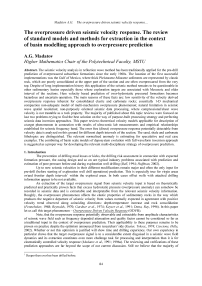The overpressure driven seismic velocity response. The review of standard models and methods for extraction in the context of basin modelling approach to overpressure prediction
Автор: Madatov A.G.
Журнал: Вестник Мурманского государственного технического университета @vestnik-mstu
Статья в выпуске: 1 т.8, 2005 года.
Бесплатный доступ
The seismic velocity analysis in reflection wave method has been traditionally applied for the pre-drill prediction of overpressured subsurface formations since the early 1960s. The location of the first successful implementations was the Gulf of Mexico, where thick Pleistocene-Miocene sediments are represented by clastic rock, which are poorly consolidated at the upper part of the section and are often overpressured from the very top. Despite of long implementation history this application of the seismic method remains to be questionable in other sedimentary basins especially those where exploration targets are associated with Mesozoic and older interval of the sections. Here velocity based prediction of over-hydrostatic pressured formations becomes hazardous and uncertain operation. The main reasons of these facts are: low sensitivity of the velocity derived overpressure response inherent for consolidated clastic and carbonate rocks; essentially 1-D mechanical compaction non-adequate model of multi-mechanism overpressure phenomenon; natural limitation in seismic wave spatial resolution; non-purposely oriented seismic data processing, where compressional/shear wave velocity is not treatable as a rock property. The majority of published about this topic reviews were focused on last two problems trying to find the best solution on the way of purpose-built processing strategy and perfecting seismic data inversion approaches. This paper reviews theoretical velocity models applicable for description of a target phenomenon in connection with results of ultra-sonic lab measurements and empirical relationships established for seismic frequency band. The error free (direct) overpressure response potentially detectable from velocity data is analysed on this ground for different depth intervals of the section. The sand, shale and carbonate lithologies are distinguished. The relevant normalised anomaly is estimating for speculative and real case examples. The combining of basin scale models of deposystem evolution with full waveform inversion approach is suggested as a proper way for developing the relevant multi-disciplinary strategy of overpressure prediction.
Короткий адрес: https://sciup.org/142100819
IDR: 142100819


